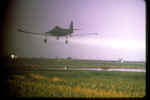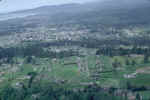 |
 |
Bibliography | Home |
![]()
There are many different types of substances that may pollute water. Water quality impairment may include petrochemical pollution, bacterial pollution, and organic and inorganic chemicals, including pesticides.
Petroleum Pollution: A major problem throughout California is leaking storage tanks for gasoline, including the highly toxic new additive MTBE. This concern is mostly connected to ground water and drinking water pollution but may effect fish if there is a connection between surface water and ground water. A more direct effect on fish and streams is the discharge of oil and grease from industrial areas or city or suburban streets during winter rains. May et al. (1994) found that discharge of these substances became measurable in urban streams when paving and total impervious area reached 30%.
Bacterial Pollution: Septic tanks in rural areas and runoff from pastures may elevate levels of Escherichia coli (E. coli) bacteria in surface waters. This may be a particular problem in north coastal California if there is aqua culture in bays where surrounding uplands are pasture, such as in Humboldt Bay and Tomales Bay. The anaerobic bacterium Bacteriodes vulgatus is an indicator of for human fecal sources in water samples (O'Connell et al., 2000). The pathogenic bacteria Salmonella typhirium may also occur (O'Connell et al., 2000).
Organic Chemical Pollutants/Pesticides: Organic chemicals exist in many forms but the most serious hazards posed for fish and water quality are those falling under the broad classification of pesticides. These chemicals are used pervasively in our society in large scale agriculture and back yard gardening, but studies indicate that they may be hazardous to Pacific salmon and to humans (Ewing, 1999, Lind, 2002). Legally used backyard chemicals, such as Diazinon, are now showing up in measurable levels in streams throughout the Pacific Northwest (Lind, 2002). Diazinon runoff into San Francisco Bay has lead to a TMDL for this substance for urban creeks, which drain into the bay (SFBRWQCB, 2002). Lind (2002) noted that "Diazinon at very low concentrations can impair the salmonís sense of smell, resulting in a decreased ability to avoid predators". See the excerpts from Ewing, 1999 for a summary of pesticide effects on salmon, steelhead and trout and the dynamics of pesticides in the environment.
 |
 |
| Crop duster spraying chemicals on a field. | Urbanization increases paved areas and runoff of water that may be polluted with nutrients petroleum products, herbicides and pesticides. |
Inorganic
Chemicals and Heavy Metals:
From Deas and Orlab (2000) "Heavy Metals are common inorganic chemical
pollutants. Heavy metals found in aquatic ecosystems include, but are not limited
to, lead, copper, zinc, cadmium, and mercury. The toxicity of metals varies
greatly with pH, water hardness, dissolved oxygen levels, salinity, temperature
and other parameters. Physiological impacts occur at small concentrations. For
example, growth and mortality of rainbow trout are effected at copper levels
of 17 micrograms per liter.
However, the toxicity of copper is highly dependent on water chemistry. In very
soft water 32 micrograms per liter
proved lethal, but in hard water the lethal tolerance for trout ranged up to
1100 micrograms per liter
(Colt et al, 1979). (Hardness is typically represented as the sum of calcium
and magnesium concentrations in milligrams per liter.) Inorganic chemicals,
such as polychlorinated biphenyl (PCB and phthalic acid (PAE), used in the plastics
and electrical industry, can sometimes be found in aqueous systems. Acute toxicity
is typically low, but significant levels may accumulate (i.e., bioaccumulation,
bio-concentration) in body tissues when fish are exposed to low levels (Sawyer
et al 1994). Colt et al (1979) reported that rainbow trout hatching from eggs
containing PCB levels of 2.7 micrograms per gram
were badly deformed, experiencing 75 percent mortality after 30 days. The drinking
water standard for PCBs in the United States is 0.5 micrograms per liter."
![]()
References
Deas, M.L. and G.T. Orlob. 1999. Klamath River Modeling Project. Project #96-HP-01. Assessment of Alternatives for Flow and Water Quality Control in the Klamath River below Iron Gate Dam. University of California Davis Center for Environmental and Water Resources Engineering. Report No. 99-04. Report 236 pp.
Cox, C. 2000 Lethal Lawns : Diazinon Use Threatens Salmon Survival, Oregon Pesticide Education Network, Northwest Coalition for Alternatives to Pesticides.. Eugene, OR. 24pp.[1740k]
Ewing, R.D. 1999. Diminishing Returns: Salmon Decline and Pesticides. Funded by the Oregon Pesticide Education Network, Biotech Research and Consulting, Inc., Corvallis, OR. 55 p. [1925k]
Krenkel, P.A. and V. Novotney. 1980. Water Quality Management. Academic Press, New York.
O'Connell, L., G. Langlois, and D. Hopkins. 2000. Investigation of nonpoint pollution sources impacting shellfish growing areas in Tomales Bay, 1995-96. Tomales Bay Shellfish Technical Advisory Committee Final Report. 173 pp. [6.7Mb]
Sawyer, C.N., P.L. McCarty, G.F. Parkin. 1994. Chemistry for Environmental Engineering. McGraw-Hill, Inc. San Francisco.
Water Quality Assessments. 1996. Water Quality assessments: A guide to the use of biota, sediments and water in environmental modeling. Ed. D. Chapman. Published on behalf of UNESCO United Nations Education, Scientific, and Cultural Organization; WHO World Health Organization; UNEP United Nations Environmental Programme. Chapman & Hall, London.
![]()
Web sites for more information about pollutants
EPA Current
Drinking Water Standards: Table has all limits for all pollution types.
http://www.epa.gov/safewater/mcl.html
EPA Micro-organisms
and drinking water
http://www.epa.gov/safewater/mcl.html#micro
U.S.
Environmental Protection Agency. ECOTOX : A source for locating single chemical
toxicity data for aquatic life, terrestrial plants and wildlife
http://www.epa.gov/ecotox/.
U.S.
Geological Survey, National Water Quality Assessment Program. National assessment
of pesticides in the streams, rivers, and ground water of the United States:
Pesticide National Synthesis Project
http://ca.water.usgs.gov/pnsp/
USGS
Pesticides in Surface Waters
http://ca.water.usgs.gov/pnsp/rep/fs97039/
University of Nebraska, Lincoln Institute of Agricultural and Natural Resources: Pesticide Bookmark http://ianrwww.unl.edu/ianr/pat/pestbkmk.htm
University
of California-Davis, Oregon State University, Michigan State University, Cornell
University, and the University of Idaho. EXTOXNET - The EXtension TOXicology
NETwork: Pesticide Information
http://ace.orst.edu:80/info/extoxnet/ghindex.html
PCBís
in Fish
http://www.slh.wisc.edu/ehd/organics/pcbanimal.html
Suits of EPA on Salmon and Pesticides http://www.pestlaw.com/x/press/2001/ELDF-20010130A.html
Many
links to information about Pesticides and Fish
http://www.pesticide.org/factsheets.html
Mercury:
http://ca.water.usgs.gov/mercury/fs06100.html
| www.krisweb.com |